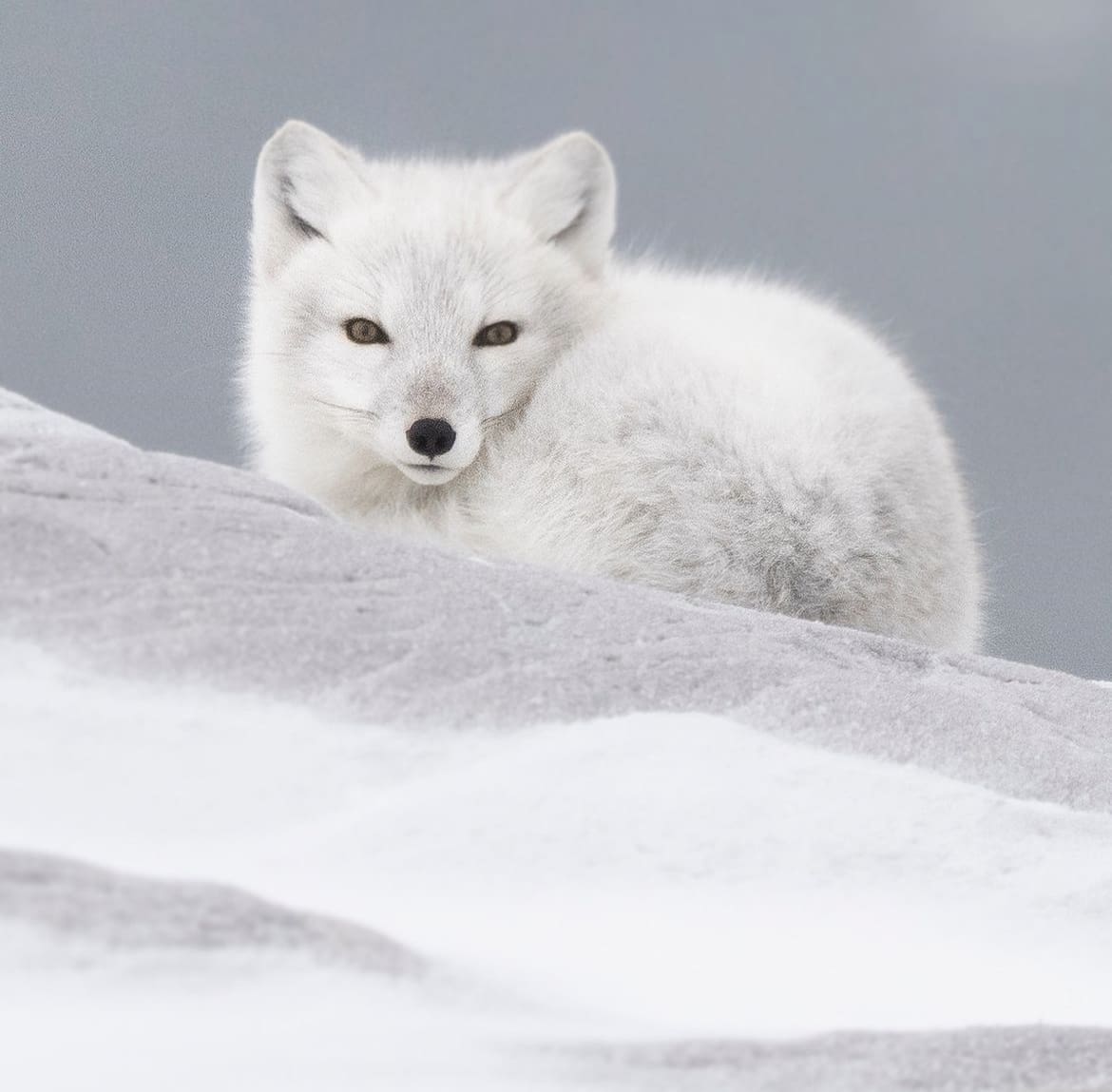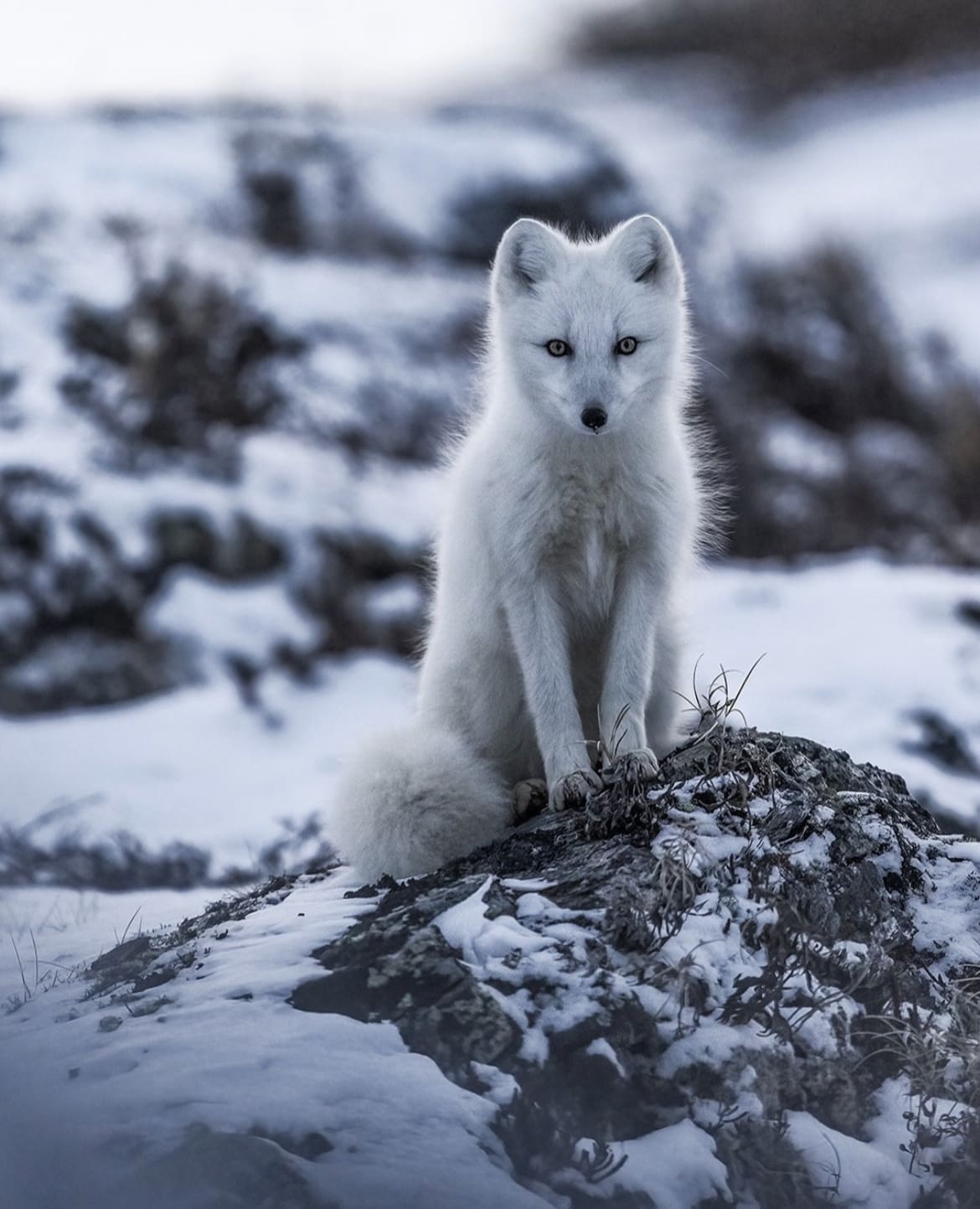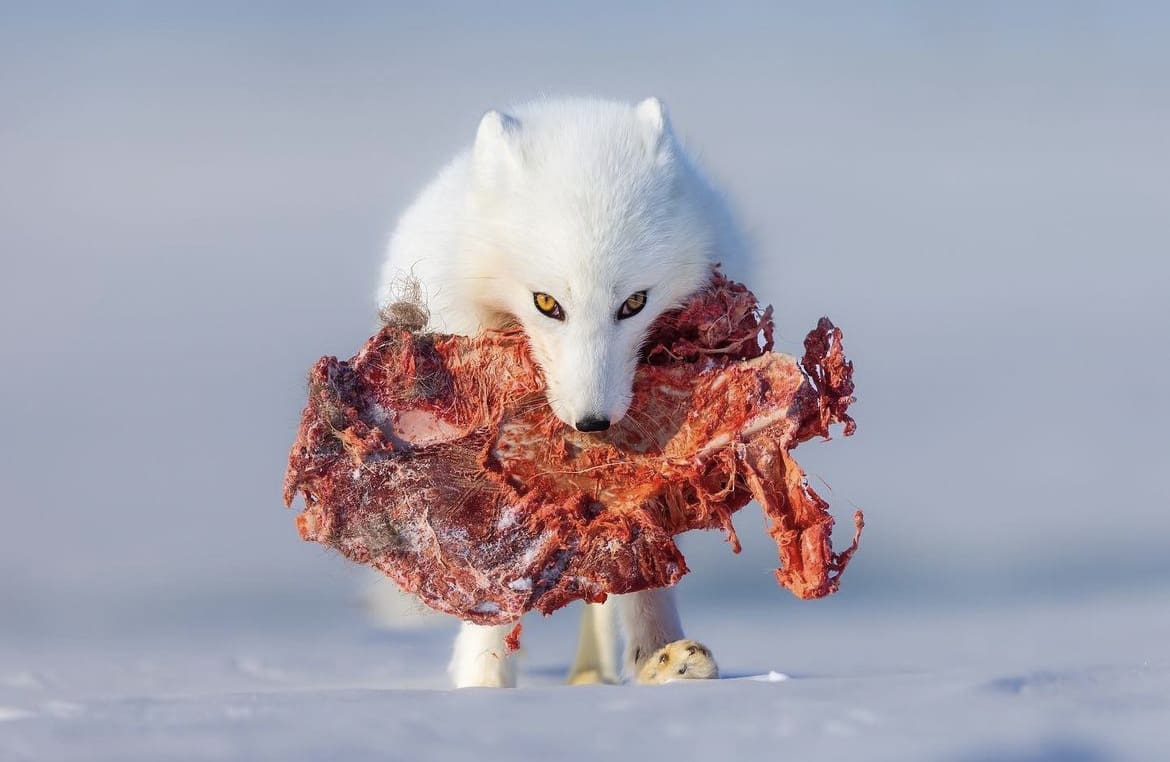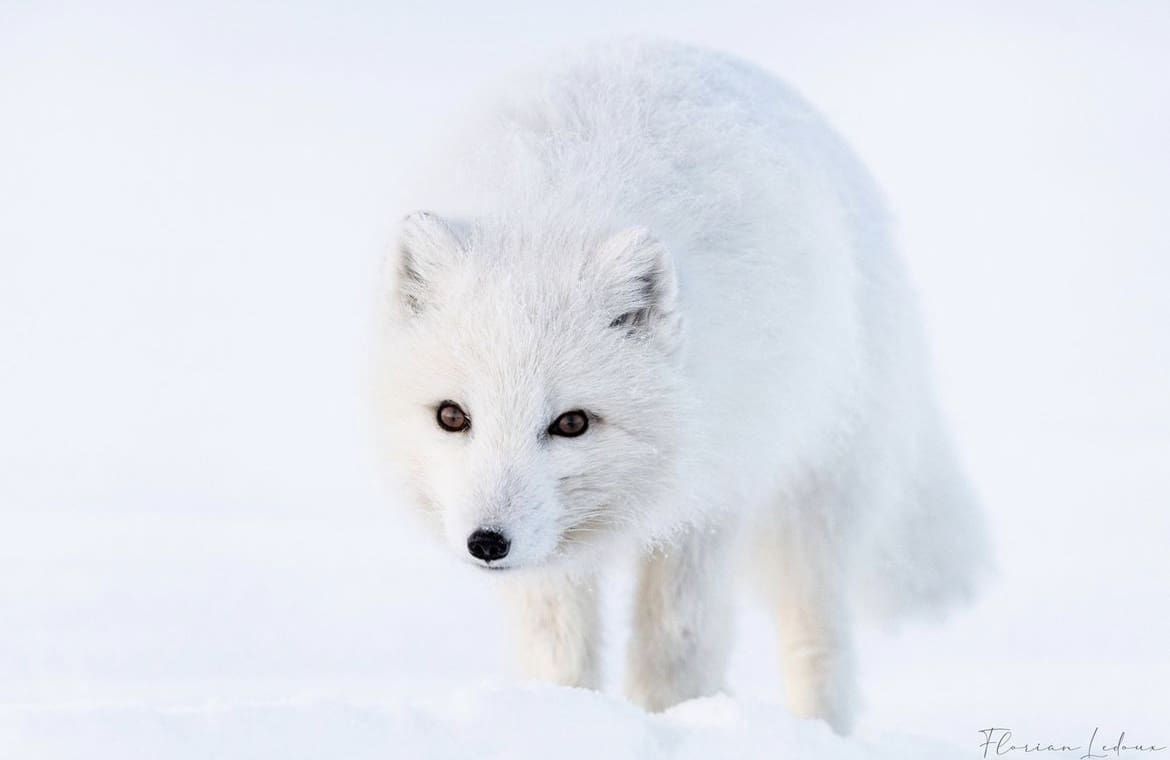[social_warfare]
Picture this: a small, nimble creature darts across the icy tundra, its fur as white as the snow beneath its paws. This isn’t a scene from the latest fantasy epic but the real-life Arctic, home to one of the most fascinating creatures on the planet—the Arctic Fox.
Known scientifically as Vulpes lagopus, these foxes are not just survivors; they’re thrivers in one of the harshest climates on Earth. So, grab your virtual snow boots, and let’s dive into the world of the Arctic Fox, a tale of adaptability, resilience, and fluffy tails.
What is the Arctic Fox?
The Arctic Fox, a small mammal belonging to the canid family, is a master of the Arctic chill. Think of it as the Houdini of the polar world, with a knack for surviving in temperatures that would make most of us cry for a hot chocolate rescue.
These foxes don’t just live in the Arctic; they embody it, from their frost-proof fur to their ice-hopping agility. They play a crucial role in the Arctic ecosystem, acting as both predator and prey.
Their diet helps control rodent populations, while they themselves are a key snack for larger predators. It’s the circle of life, Arctic style, complete with snowflakes and fur coats.

What do Arctic Foxes Look Like?
Arctic Foxes are the fashion models of the tundra, sporting two distinct looks depending on the season. In winter, they flaunt a pristine white coat that makes them nearly invisible against the snow—a handy trick for avoiding predators and sneaking up on dinner. Come summer, they switch things up with a brown or gray outfit, perfect for blending into the rockier, snow-free landscapes.
They’re not just about looks, though. These foxes are compact and rounded, designed to minimize heat loss. Their small ears and short muzzle aren’t just adorable; they’re crucial for reducing exposure to the bitter cold. Picture a fluffy, four-legged snowball, and you’re pretty much there.
How Big Are Arctic Foxes?
Don’t let their plush coats fool you; Arctic Foxes are on the smaller side, even by fox standards. They tip the scales at about 3 to 8 kilograms (6.5 to 17.5 pounds), which is roughly the weight of a large cat or a very small dog. From nose to fluffy tail, they measure about 46 to 68 centimeters (18 to 27 inches) long, with an additional tail length of up to 35 centimeters (13.7 inches). It’s this compact size that helps them conserve heat and navigate the Arctic’s challenging terrain. So, while they might not win any awards for size, their survival skills are off the charts.

Arctic Fox Fur
The fur of an Arctic Fox is not just a fashion statement; it’s a survival tool. Their fur is one of the warmest of any mammal, thanks to a dense undercoat shielded by thick, longer guard hairs. This furry marvel allows them to endure temperatures as low as -50°C (-58°F).
In winter, their coat thickens to provide extra insulation, while in summer, it thins out, showing off a sleeker, albeit still incredibly insulated, look. It’s like having a built-in, all-weather wardrobe that’s both stylish and practical.
Arctic Fox Teeth
Dive into that charming, whiskered face, and you’ll find a set of teeth designed for a carnivorous lifestyle. Arctic Foxes are equipped with sharp, pointed teeth perfect for gripping and slicing their prey.
These dental tools are essential for a diet that includes everything from rodents to fish. Their teeth are not just for eating; they’re a crucial part of their hunting arsenal, allowing them to quickly dispatch their meals before the harsh Arctic elements can reclaim them.
Arctic Fox Colouration
The Arctic Fox’s coloration is a masterclass in camouflage. In the winter, their coats turn a snowy white, blending seamlessly with the surrounding ice and snow. This not only helps them stalk prey undetected but also keeps them hidden from predators. Summer brings a transformation, with their coats shifting to brown or gray to match the summer tundra’s rocks and plants. This color change is crucial for their survival, providing year-round stealth mode in their constantly changing environment.
The Arctic Fox’s ability to adapt is not just impressive; it’s essential for survival in the unforgiving Arctic. Their fur, teeth, and coloration are all finely tuned to ensure they remain at the top of their game, whether they’re hunting, hiding, or simply trying to stay warm. These adaptations are a testament to the resilience of Arctic wildlife and the intricate balance of ecosystems at the Earth’s extremes.

What Do Arctic Foxes Eat?
Arctic Foxes are not picky eaters. Their diet is a smorgasbord of Arctic cuisine, ranging from small mammals like lemmings and voles to birds, eggs, and even carrion. During the summer, when the Arctic bursts into brief but abundant life, these foxes might even snack on berries and insects.
It’s this opportunistic dining strategy that ensures they find food year-round, even when the pickings are slim. They have a particular fondness for lemmings, and their population can wax and wane with the lemming cycles, highlighting the interconnected nature of Arctic ecosystems.
How Do Arctic Foxes Hunt?
Hunting in the snow is no small feat, but Arctic Foxes are masters of the craft. They employ a mix of stealth and acute hearing to detect prey moving underneath the snow. Once they’ve honed in on their target, they perform a characteristic hunting leap, breaking through the snow to catch their unsuspecting prey.
This pounce is a mix of calculation and instinct, showcasing the Arctic Fox’s remarkable adaptation to its icy realm. Their hunting prowess ensures they can sustain themselves even in the deep freeze of winter when the landscape turns into a seemingly barren, snow-laden expanse.

Arctic Fox Social Structure
Arctic Foxes are solitary hunters, but when it comes to the breeding season, they’re all about family. They form monogamous pairs for the breeding season, and both parents pitch in to raise the young. The size of their families can be quite large, with a single litter containing up to 14 pups, although sizes from 5 to 8 are more common.
These family units are tight-knit, with both parents teaching their young how to navigate the Arctic world. Outside of breeding season, Arctic Foxes can sometimes be found forming small, temporary groups, especially in areas with abundant food sources. Their social structure is flexible, adapting to the changing seasons and availability of resources, further evidence of their incredible adaptability.
How Do Arctic Foxes Reproduce?
When spring whispers through the Arctic, it signals the start of the breeding season for Arctic Foxes. These creatures are monogamous during the season, forming pairs that work together to ensure the survival of their offspring. After a gestation period of about 52 days, the female gives birth to a litter, which can range impressively from 5 to as many as 14 pups, though the typical number is around 8.
The dens they use for birthing have often been passed down through generations, some over centuries, nestled within the rugged Arctic landscape. Both parents are involved in rearing the young, with the male hunting and the female nursing and guarding the pups. This close-knit family structure is essential for the survival of the young in the challenging Arctic environment.
How Long Do Arctic Foxes Live?
In the wild, the life of an Arctic Fox is intense and, sadly, often short. They live on average 3 to 4 years, a testament to the harshness of their environment. Predation, competition for food, and the extreme climate are constant challenges.
However, in captivity, where threats are minimized, these foxes can live up to 14 years. This stark difference underscores the relentless pressures faced in the wild and the remarkable resilience of these animals to survive as long as they do.

Are Arctic Foxes Aggressive?
Despite the harshness of their environment, Arctic Foxes are not typically aggressive animals, especially towards humans. Their primary concern is survival, not confrontation. In the wild, they are more likely to flee than fight when encountered, a flight response that serves them well in avoiding predators and human interactions.
However, like any wild animal, they can display aggression if cornered or threatened, especially when protecting their young or territory. Their behavior towards other Arctic Foxes can vary, from competitive during mating season to cooperative when raising their young or hunting in areas with abundant food.
How Many Arctic Foxes Are There in the Wild?
Estimating the population of Arctic Foxes in the wild is a challenging task due to the vast and remote areas they inhabit. However, their numbers are believed to fluctuate significantly, largely influenced by the availability of their primary food source, lemmings. During years when lemmings are abundant, Arctic Fox populations can boom, leading to increased pup survival rates.
Conversely, during years of lemming scarcity, their numbers can decline sharply. Although exact numbers are difficult to pin down, conservation efforts and studies continue to monitor these populations to better understand their dynamics and support their survival.
Are Arctic Foxes Endangered?
The conservation status of Arctic Foxes varies by region. Globally, they are not considered endangered and are listed as “Least Concern” by the IUCN Red List. However, this status belies regional disparities. For instance, in Scandinavia, particularly Finland, Sweden, and Norway, Arctic Fox populations have faced significant declines due to overhunting in the past and are now considered critically endangered in these areas.
Conservation efforts, including legal protection, habitat restoration, and supplemental feeding programs, have been initiated to help recover these populations. Climate change poses a long-term threat across their range by altering their habitat and the availability of prey.

Threats to Arctic Foxes in the Wild
Arctic Foxes face a variety of threats in their icy domain. Climate change is perhaps the most significant, impacting their habitat by reducing the extent of sea ice and snow cover, which affects their hunting strategies and exposes them to more competition and predation.
Additionally, changes in prey availability, particularly the cyclical populations of rodents like lemmings, can have a profound impact on their survival rates. Human activities, including trapping for fur and disturbance of their natural habitats, also pose risks, although many regions now have protections in place for these foxes.
The introduction of red foxes into Arctic Fox territories, driven by warming temperatures, has increased competition for food and introduced new predators to their environment.
Where to See Arctic Foxes in the Wild
The Arctic Fox can be seen across various Arctic regions, each offering unique landscapes and experiences. Some of the best places to observe these foxes include:
- Svalbard, Norway: This Arctic archipelago is home to a sizable population of Arctic Foxes, where they can often be seen hunting or playing in the snow.
- Wrangel Island, Russia: A UNESCO World Heritage site, this remote island is known for its high density of Arctic Fox dens.
- Churchill, Manitoba, Canada: While better known for polar bears, Churchill’s vast tundra landscapes also provide a home to Arctic Foxes, especially visible during the winter months.
- Iceland: While not part of the continental Arctic, Iceland’s tundra regions offer the chance to see Arctic Foxes, particularly in the Hornstrandir Nature Reserve.

Tips for Spotting Arctic Foxes
Spotting an Arctic Fox in the wild can be a thrilling experience, but it requires patience, respect for nature, and a bit of luck. Here are some tips to increase your chances:
- Visit during the right season: Winter is often the best time to see Arctic Foxes, as their white coats stand out against the snow. However, summer can also be rewarding, with foxes more active during the breeding season.
- Look for tracks in the snow: Fox tracks can lead you to active dens or hunting grounds, especially after a fresh snowfall.
- Keep a safe distance: Use binoculars or a long lens to observe foxes without disturbing them. Getting too close can stress the animals and disrupt their natural behaviors.
- Stay quiet and patient: Wildlife viewing often requires waiting quietly for long periods. Arctic Foxes are curious creatures and may come closer if they don’t feel threatened.
- Hire a local guide: Guides can provide invaluable knowledge about Arctic Fox behavior and the best spots for sightings, increasing your chances of a memorable encounter.
Fascinating Facts About the Arctic Fox
- Arctic Foxes have incredibly warm fur, allowing them to endure temperatures as low as -70°C (-94°F).
- They have a keen sense of hearing, capable of detecting prey moving under the snow from several meters away.
- Arctic Foxes can walk on ice without slipping, thanks to the fur on the soles of their feet.
Myths About the Arctic Fox
- Myth: Arctic Foxes change color to match the snow. Reality: The color change is seasonal and related to daylight length, not snow presence.
- Myth: Arctic Foxes hibernate in winter. Reality: They remain active all year, with their thick winter fur keeping them warm.
- Myth: Arctic Foxes are solitary animals. Reality: They can form small family groups, especially during the breeding season.
In wrapping up our exploration of the Arctic Fox, it’s clear these creatures are not just survivors of the Arctic but symbols of its untamed beauty and fragility. Their ability to adapt to the coldest environments on Earth is a remarkable testament to the resilience of wildlife in the face of changing climates and habitats.
